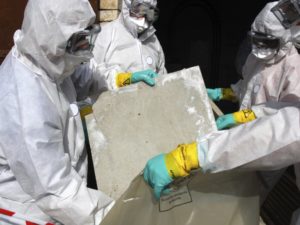
A guide to asbestos in homes
Asbestos is the name given to a group of naturally occurring minerals found in rock formations. Three types of asbestos were mined in Australia: white, blue and brown asbestos. Large deposits were mined in Western Australia and New South Wales, and there were smaller operations in Tasmania and South Australia.
Asbestos fibres are strong, heat resistant and have insulating properties. Clumps of mined asbestos can be broken down into loose fibres or fibre bundles, and can be mixed with other materials, such as cement, to produce a variety of building products. Up to 90% of the asbestos produced in or imported into Australia was used for the manufacture of building products, especially asbestos cement materials.
Which homes are at risk?
If your home was built or renovated before 1990, it is likely that it contains some form of asbestos building product – most likely asbestos cement sheeting.
Where in the home?
Asbestos-containing products used in houses
| Bonded (tightly-bound) asbestos or non-friable asbestos | Loosely-bound asbestos or friable asbestos |
| The vast majority of asbestos-containing | Some friable asbestos products may |
| products used in houses were bonded | also be found in houses, including: |
| asbestos cement materials, including: | • asbestos-rope door gaskets in |
| • roofing | wood stoves |
| • shingles and siding | • loose fill roofing insulation |
| (villa board and similar) | (not common) |
| • exterior and interior wall cladding | • spray-on insulation or soundproofing |
| • eaves | • low-density asbestos fiber board |
| • fencing | • insulation on hot-water pipes, |
| • thermal boards around fireplaces | domestic heaters and stoves |
| • water or flue pipes. | (e.g. lagging) |
| • backing material on floor tiles and | |
| vinyl flooring | |
| • carpet underlay (not common) | |
| • textured paints, decorative | |
| ceiling coatings | |
| • heat-resistant fabrics | |
| • brick and plaster sealants, fillers | |
| and some adhesive products | |
| • hail or fire damaged, or badly weathered | |
| asbestos cement materials. | |
ASBESTOS AND YOUR HEALTH
Asbestos only poses a risk to health when asbestos fibres are breathed in.
Undisturbed asbestos cement materials in good condition do not pose a health risk because the asbestos fibres are bound together in solid cement.
However, if the material is damaged or crumbling (that is, has become friable), or is disturbed by breaking, cutting, drilling or sanding, fibres are released into the air.
Friable asbestos products (such as spray-on insulation or asbestos-rope gaskets in wood stoves and heaters) also produce airborne fibres during normal use or ageing. Crumbling bonded materials, and all friable products, must be carefully managed to prevent the release of fibres into the air.
How can I tell if it is asbestos?
It is very difficult to identify the presence of asbestos just by looking at it. As a general rule, certain building materials installed before the late 1980s may contain asbestos. However, the only way to be certain is to have a sample of the material analysed by a laboratory.
Contact professional asbestos testing service in your area.
Householders may be exposed to asbestos fibers during accidental damage to asbestos materials in the home, or as a result of unsafe handling of asbestos material by tradespeople or by the householders themselves. If you have concerns or doubts about asbestos in your home, don’t take any chances with your family’s health and give us a call and we can help you.
For a quote on Asbestos Removal by Jim’s call 131 546







